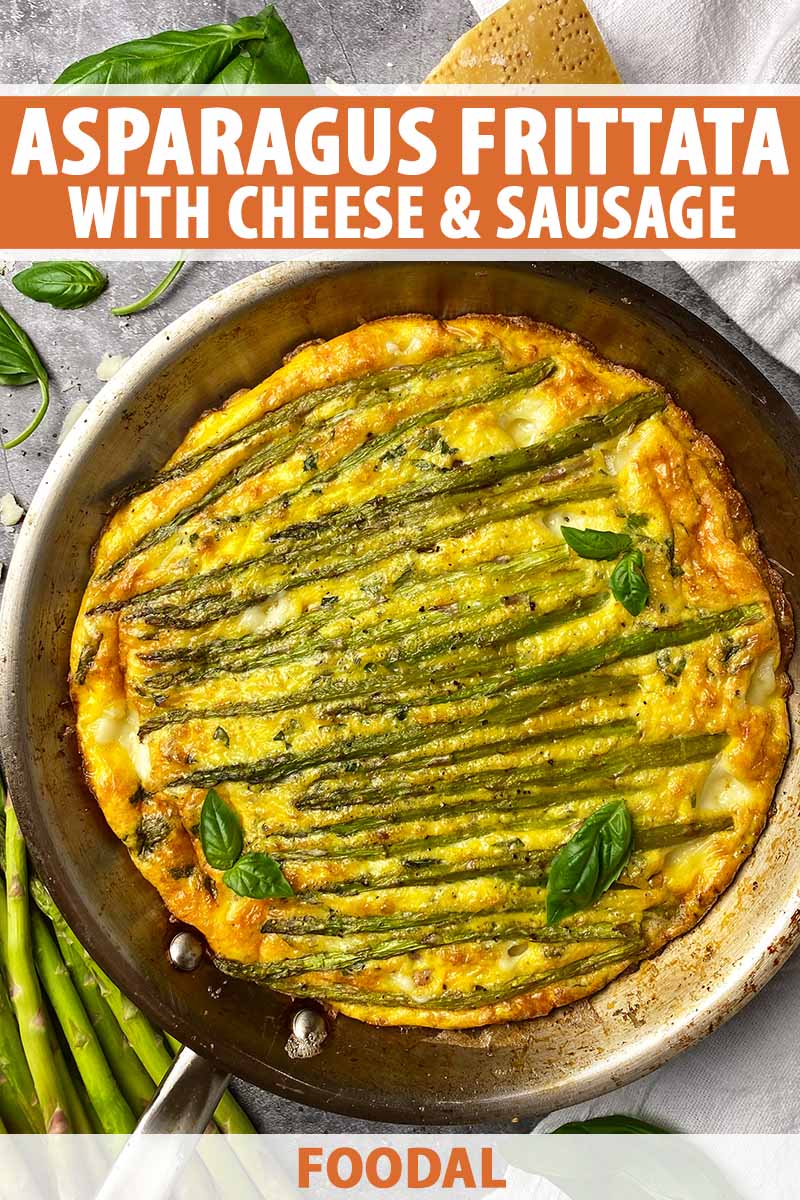Frittata, my fab friend, you’ve done it again! Well done, you!
You’ve pulled off yet another stellar breakfast idea, one that’s easy to assemble, easy to cook, and easy to enjoy!
I love a meal that’s simple to prepare while most of my brain cells are still waking up in the morning, grasping onto every drop of hot coffee I sleepily sip.
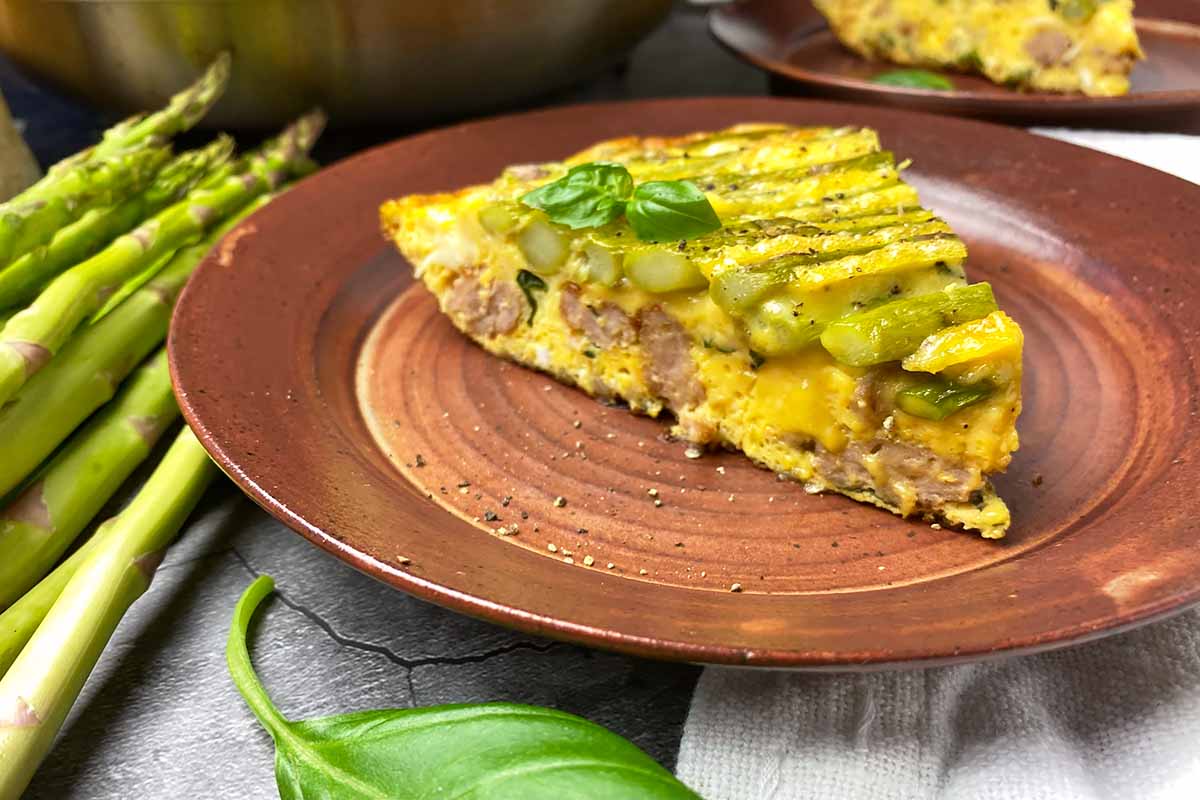
But I consider an easy breakfast recipe a real bona fide champ when it can still garner impressive admiration with a gorgeous presentation and delightful flavors.
And that’s you, my fluffy frittata!
This Italian-inspired version has it all: fluffy eggs, tender veggies, gooey cheese, and savory meat.
The trick to extracting the most flavor and the best texture from all of these ingredients is to divide essential prep and cooking steps.
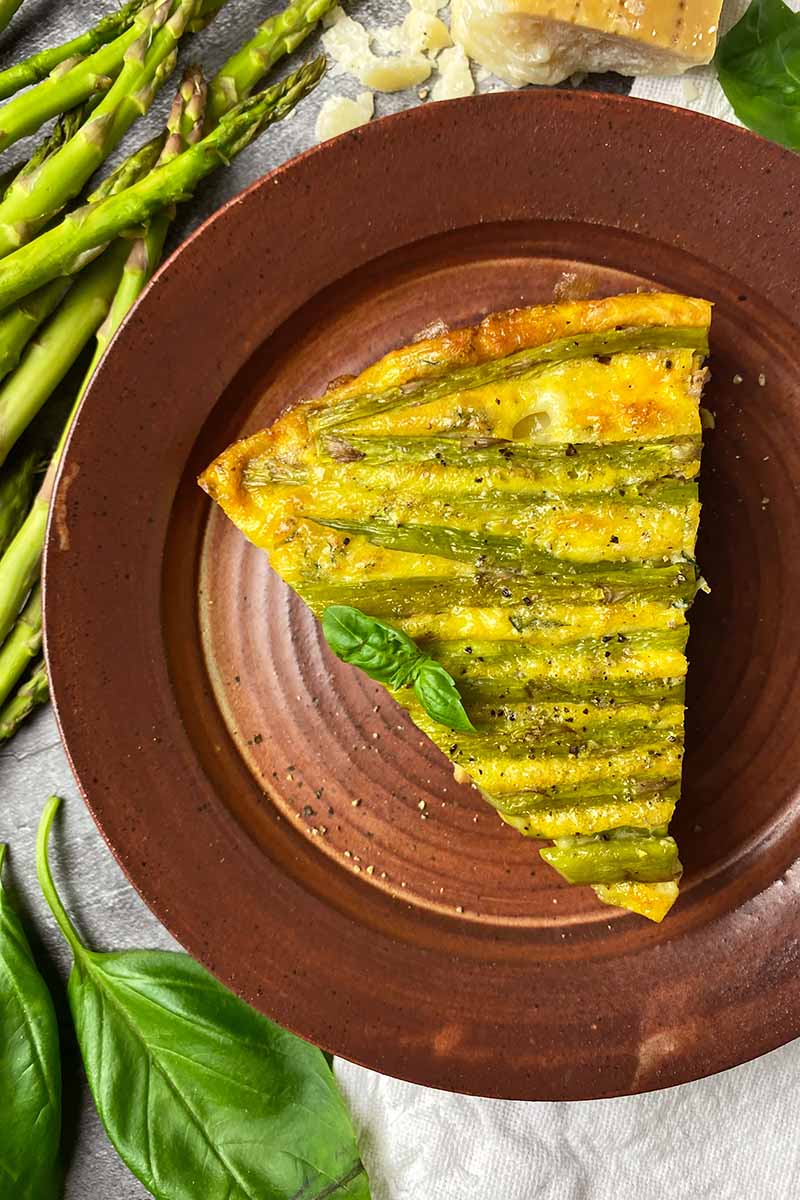
While this is indeed an easy recipe, you’ll still need to follow some culinary common sense – you can’t just whisk all the ingredients together in a big bowl, dump it in a pan, and expect perfection!
Before the final bake in the oven, you need to roast the asparagus, which amplifies its natural sweetness and gives a lightly browned exterior.
Sauteing the garlic and scallions also helps to develop deeper flavors, eliminating their raw abrasiveness. Cooking the sausage in the same pan as the garlic and scallions will brown the meat to crispy perfection, rewarding you and your taste buds with a flavorful sear.
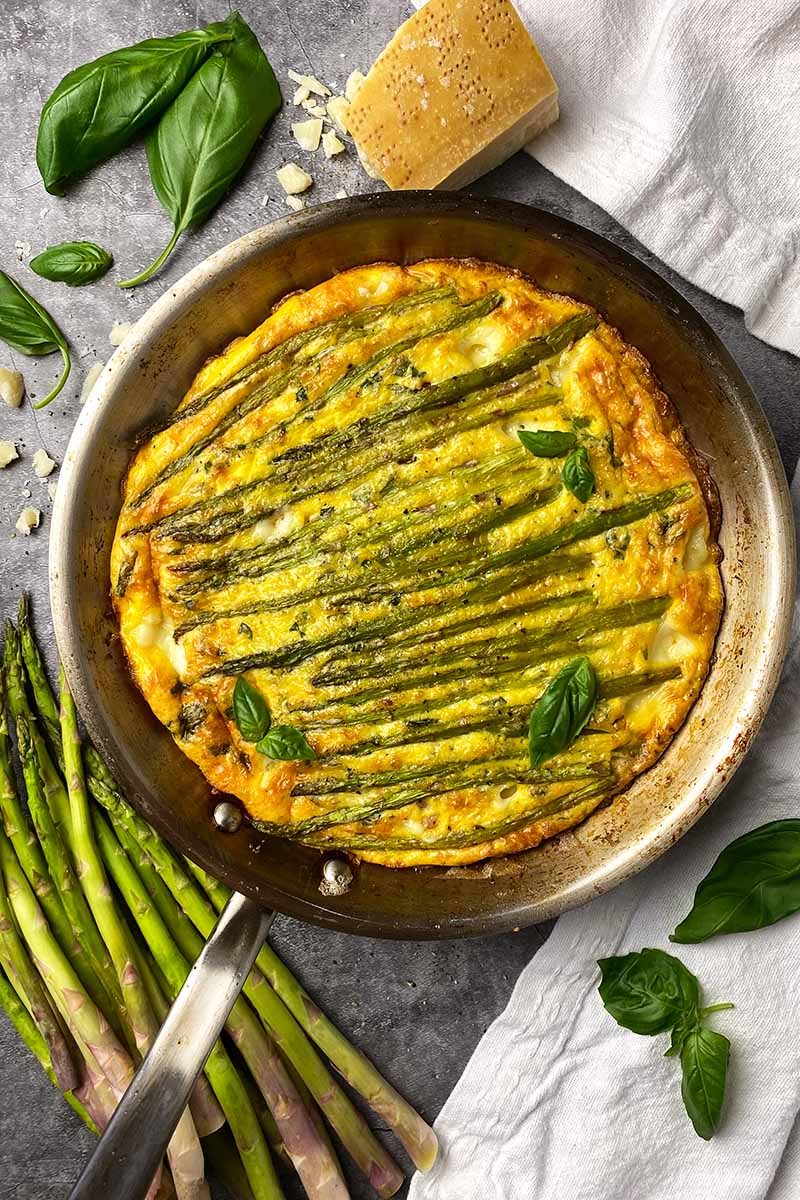
Two different cheeses serve two different purposes. First, whisking the freshly grated Parmigiano Reggiano directly into the eggs adds a salty personality to the base.
Second, dotting the top of the egg mix with cubes of a semi-firm cheese like Fontina Val d’Aosta results in gooey, melted pockets of joyous indulgence as the dish bakes.
You can cut and serve the frittata directly from the pan for a more effortless and casual presentation. But as long as you gently release it from the bottom and sides of the pan with a spatula, you should be able to cleanly remove it whole and transfer it to a serving platter.
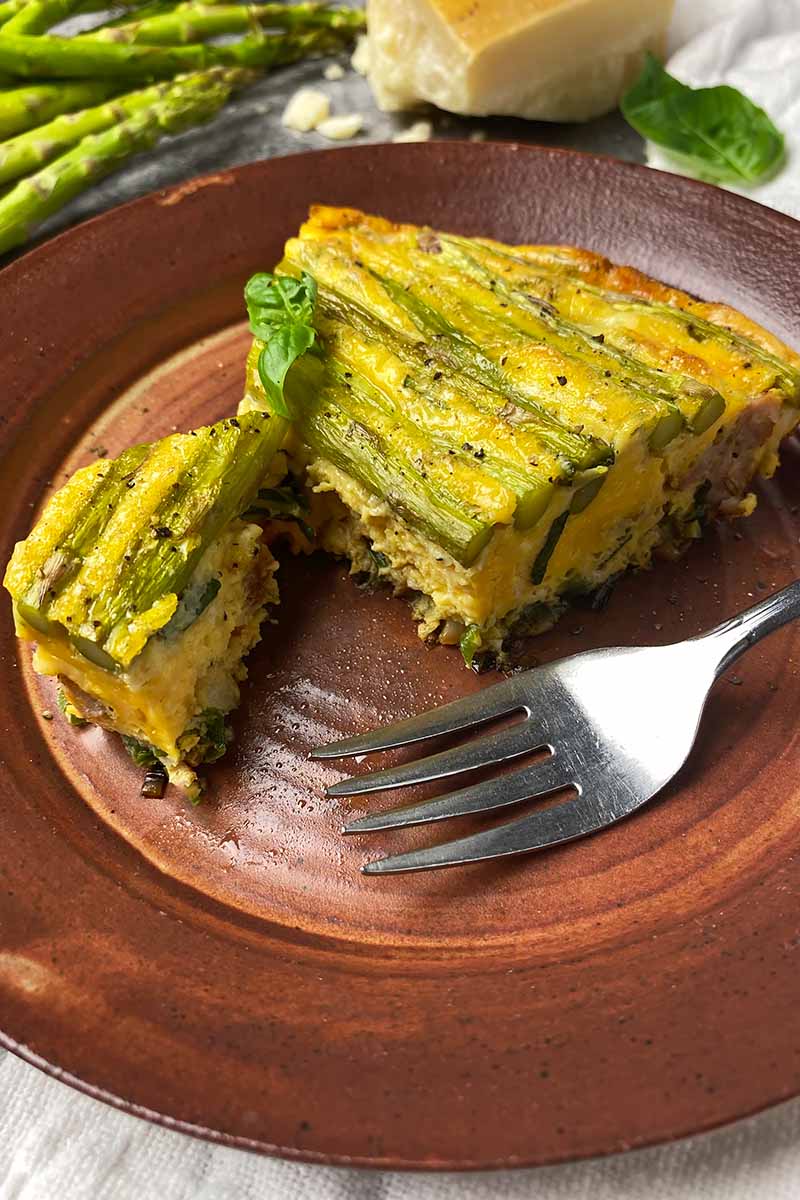
In my household, a typical frittata – and mostly any eggy breakfast, for that matter – is incomplete without hefty dashes of Tabasco hot sauce.
But in this case, do as the Italians do and place a few small dollops of jarred, chopped Calabrian peppers on top for a jolt of spice and zing that’s better than any cup of coffee!
Print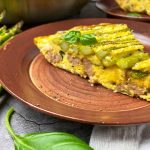
Roasted Asparagus, Cheese, and Sausage Frittata
- Total Time: 50 minutes
- Yield: 8 servings 1x
Description
Our Italian-inspired frittata dish has it all for a savory breakfast, with roasted asparagus, seared sausage, and generous amounts of cheese.
Ingredients
- 1 bunch fresh asparagus (about 1 pound), tough ends trimmed
- 1 1/2 tablespoons olive oil, divided
- 1/2 pound bulk sweet Italian sausage
- 4 large cloves garlic, minced
- 4 scallions, white and light green sections thinly sliced
- 10 large eggs
- 1/4 cup heavy cream
- 1/4 cup roughly chopped fresh basil (about 4 large leaves)
- 4 ounces Parmigiano Reggiano, grated (about 3/4 cup grated)
- 4 ounces Fontina Val d’Aosta, cubed
- 1/2 teaspoon kosher salt, divided
- 1/4 teaspoon freshly cracked black pepper, divided
Instructions
- Preheat the oven to 400°F. Line a baking sheet with aluminum foil or a silicone mat.
- Toss the asparagus in 1/2 tablespoon olive oil on the prepared baking sheet. Assemble them in a single layer and sprinkle with 1/4 teaspoon salt and 1/8 teaspoon black pepper. Transfer the baking sheet to the oven and roast until the stalks are tender and slightly browned but still have some resistance when a fork is inserted into the thickest part, about 10-12 minutes. Remove the baking sheet from the oven and set aside to cool. Leave the oven on.
- Heat 1/2 tablespoon olive oil in an oven-safe 10-inch skillet on the stovetop over medium-high heat. Crumble the sausage into the pan and cook until browned on the outside and completely cooked on the inside, about 5 minutes. Stir only occasionally to allow the meat to sear, breaking up larger chunks as it cooks with a sturdy spoon.
- Remove the sausage and place on a plate lined with paper towels. Drain most of the fat from the skillet, leaving enough to thinly coat the bottom.
- Add the garlic, scallions, and remaining salt and pepper into the same skillet and cook over medium-high heat, stirring occasionally, until lightly browned and aromatic, about 2-3 minutes. Stir in 1/2 tablespoon olive oil and evenly disperse the garlic, scallions, and oil to thinly cover and coat the bottom of the skillet.
- As the garlic and scallions are cooking, whisk together the eggs, heavy cream, basil, grated Parmigiano Reggiano cheese.
- While keeping the heat at medium-high, pour the egg mixture into the skillet with the garlic and scallions. Arrange and evenly disperse the asparagus, sausage crumbles, and cubed Fontina cheese on top.
- Allow the egg mixture to cook undisturbed for 2-3 minutes on the stovetop over medium-high heat to develop a lightly browned crust on the bottom.
- Transfer the skillet to the oven and bake for 12-15 minutes, or until the frittata is mostly set with just a slight jiggle in the center when you gently shake the skillet.
- Remove the skillet from the oven and allow to cool for 1-2 minutes. Slice into wedges and serve while still hot.
- Prep Time: 20 minutes
- Cook Time: 30 minutes
- Category: Frittata
- Method: Stovetop/Oven
- Cuisine: Breakfast
Keywords: asparagus, frittata, sausage, cheese
Cooking by the Numbers
Step 1 – Prep
Preheat the oven to 400°F. For the most even bake, place a rack in the center of the oven. Line a baking sheet with aluminum foil or a silicone mat.
As the oven is preheating, prepare your ingredients. To save on cleaning dishes, you can use the same chef’s knife and cutting board for most of the prep.
Measure out the olive oil, heavy cream, salt, and black pepper. We love the strong, spicy bite of freshly cracked black pepper! Set out the Italian sausage.
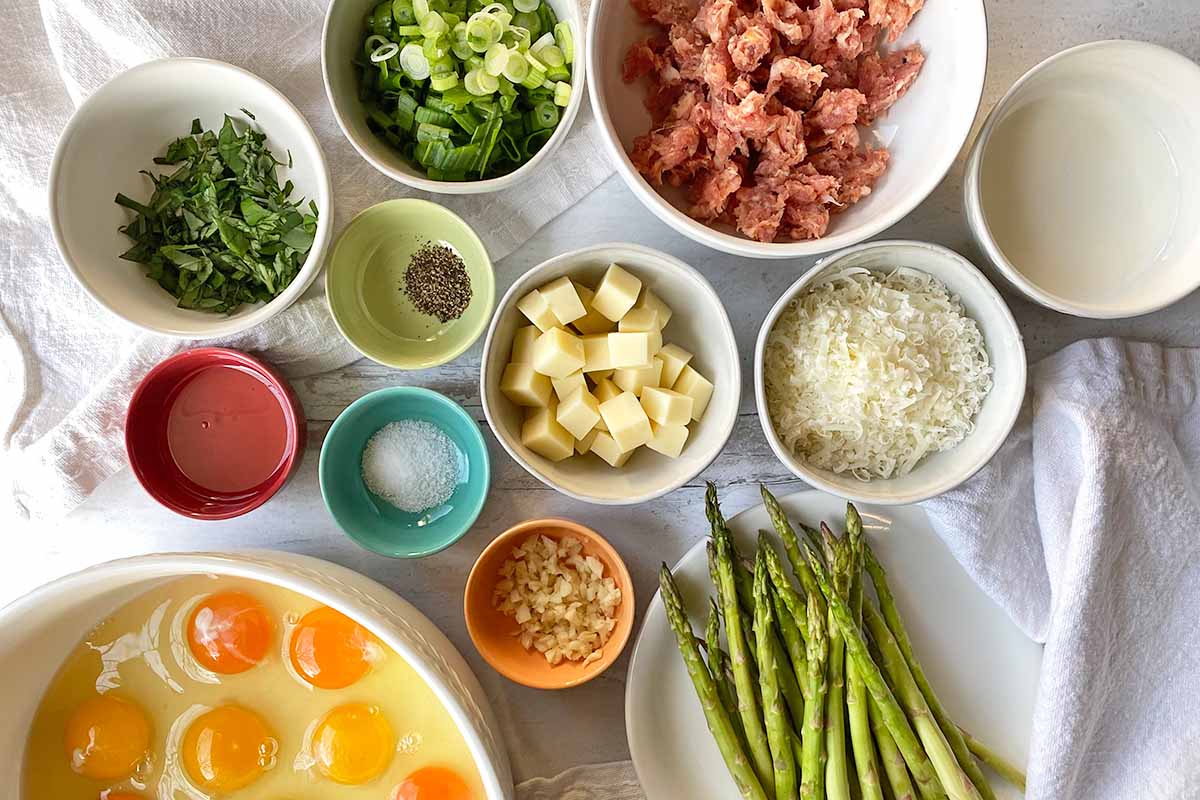
Trim the touch ends of the asparagus. Dispose of the ends, or reuse them for a different purpose, like in a pureed soup or in your compost.
Cube the Fontina cheese. Thinly slice the white and light green parts of the scallions. Mince the garlic, or use a garlic press. Roughly chop the fresh basil leaves.
Using the side with medium-sized blades of a box grater, grate the Parmigiano Reggiano cheese.
Crack the eggs into a large mixing bowl, checking for shell fragments.
Set out a 10-inch skillet that is safe to use in the oven at 400°F. The 10-inch size will yield a thicker frittata. If you’d rather have a thinner end result, use a 12-inch skillet and reduce the baking time by 3 to 5 minutes.
Step 2 – Roast the Asparagus
Toss the trimmed asparagus in 1/2 tablespoon olive oil on the prepared baking sheet. But don’t leave them in a messy pile, or else they’ll steam rather than roast!
Assemble them in a single layer and sprinkle with 1/4 teaspoon salt and 1/8 teaspoon black pepper.
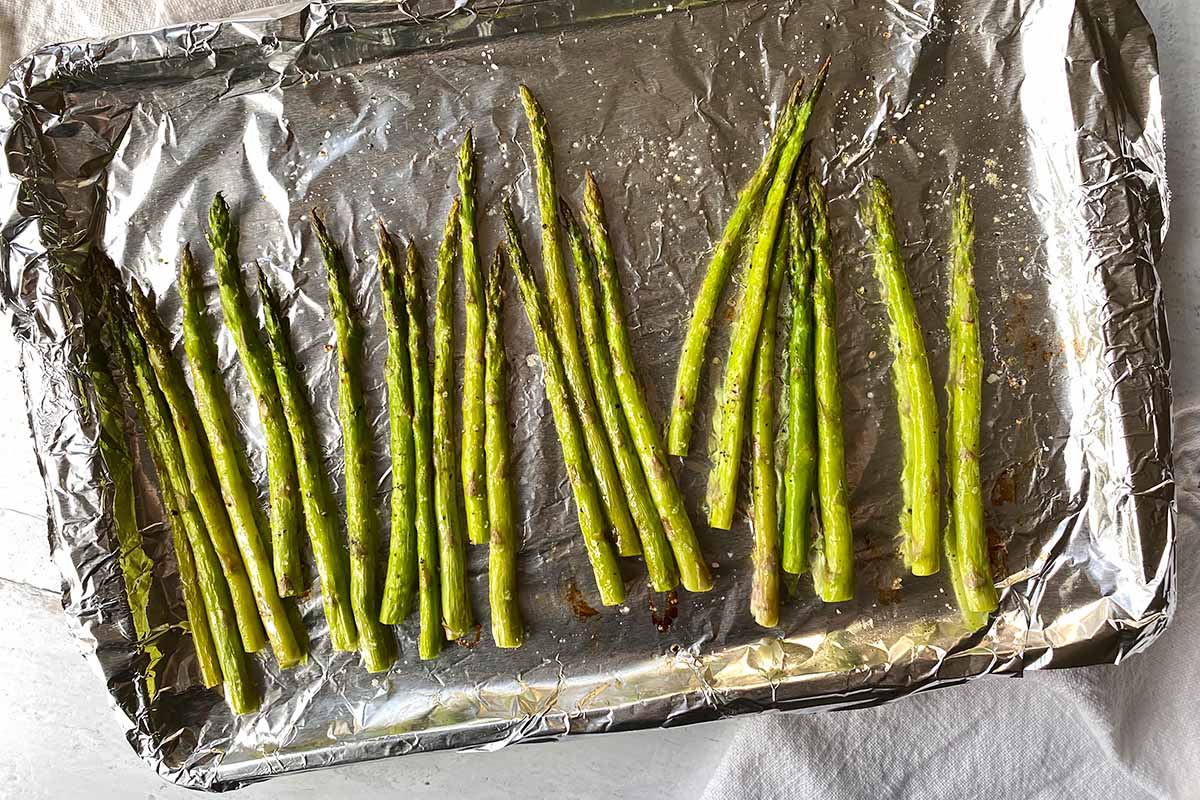
Transfer the baking sheet to the oven and roast for about 10 minutes. The stalks should be tender and a little browned, but should still have some resistance when you insert a fork into the thickest part of the stalk.
Remove the baking sheet from the oven and set aside to cool as you prepare and cook the remaining ingredients.
You’ll still need to have the oven on at the same temperature to bake the egg mix, so don’t turn it off by mistake.
Step 3 – Cook the Sausage
Pour 1/2 tablespoon olive oil into your skillet. Heat the oil on the stovetop over medium-high heat. Once hot, crumble the sausage into the pan.
Stir the sausage only occasionally as it cooks, breaking up larger chunks with a sturdy, heatproof spoon. Minimal interruptions will allow the meat to sear and develop a browned crust on the outside – a better sear yields more flavor!
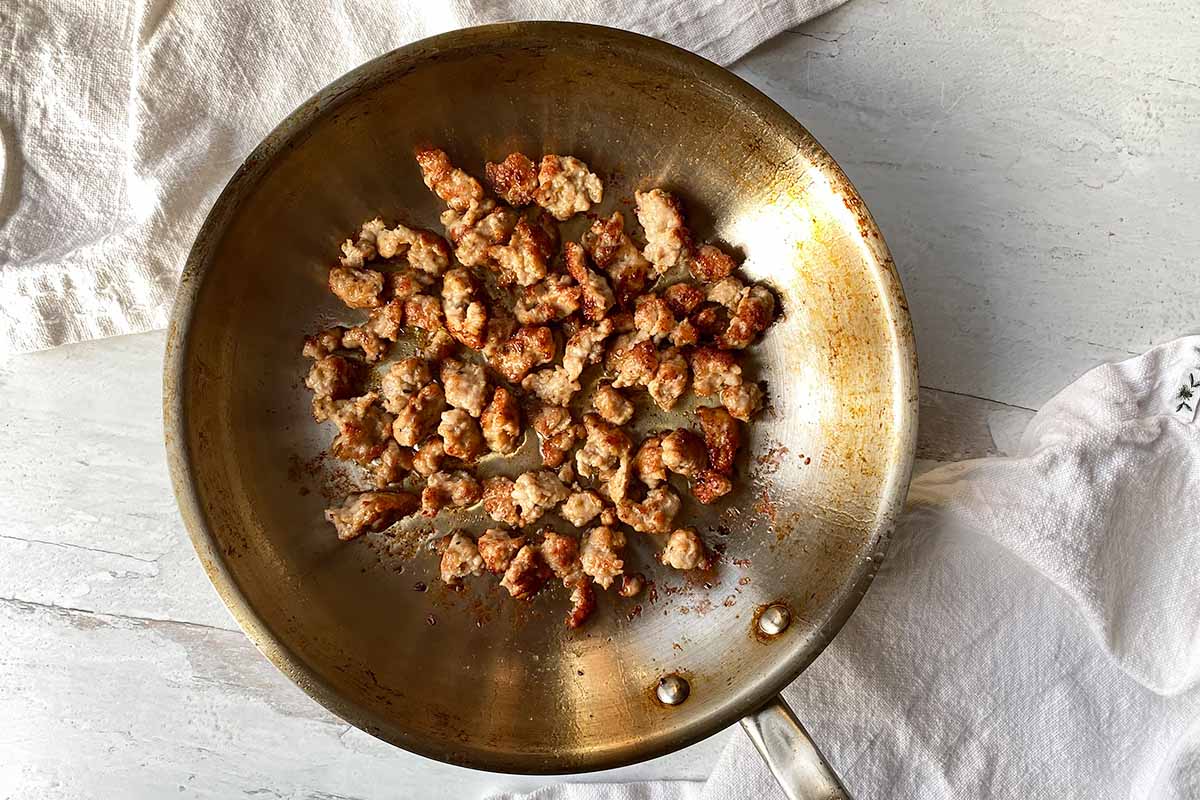
Cook the sausage until it is completely cooked on the inside. This will take about 5 minutes.
Transfer the cooked sausage to a plate lined with paper towels and set aside. Drain most of the fat from the skillet, leaving enough to thinly coat the bottom. You’ll use this fat to cook the garlic and scallions in the next step.
Step 4 – Cook the Garlic and Scallions
Add the garlic, scallions, and remaining salt and pepper into the skillet and cook over medium-high heat, stirring occasionally.
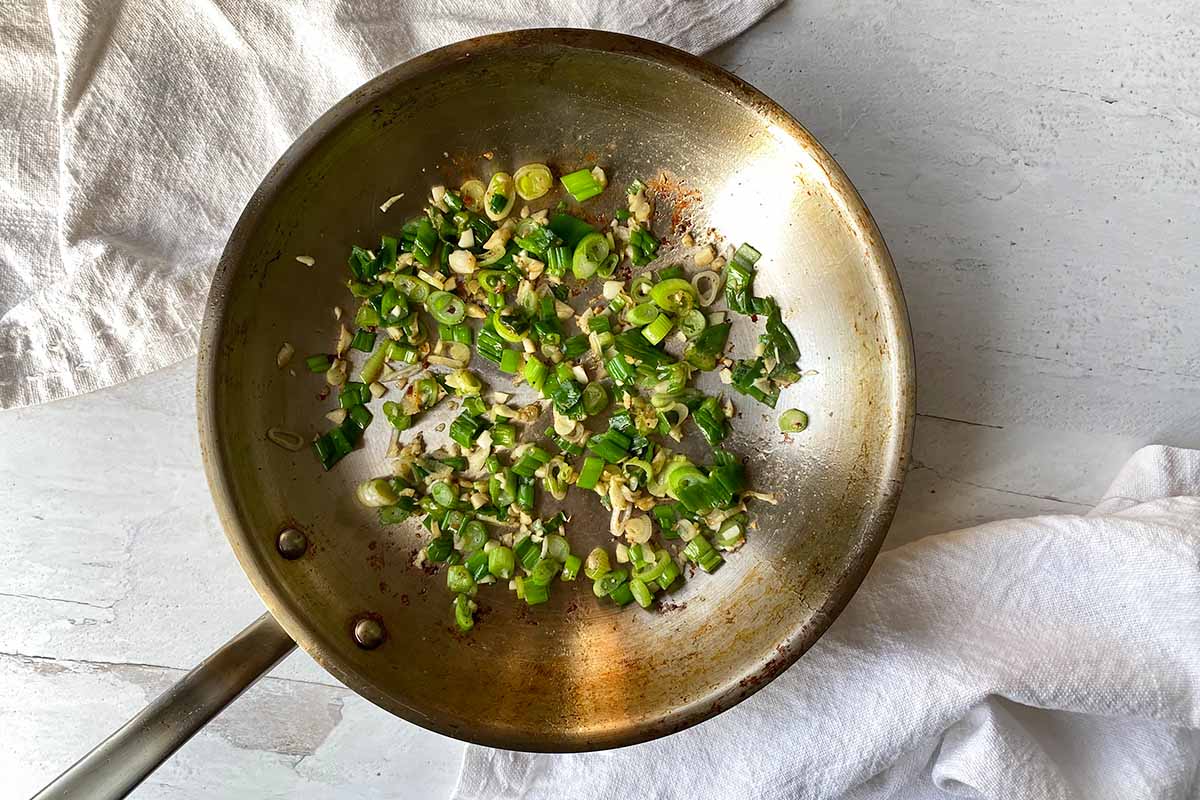
Cook until everything is lightly browned and aromatic. It won’t take too long for these more delicate ingredients to cook, only about 2 to 3 minutes.
Step 5 – Whisk Together the Egg Base
While the garlic and scallions are cooking, you can quickly whisk together the ingredients for the egg base.
But still keep your eyes on the garlic and scallions – don’t let them burn!
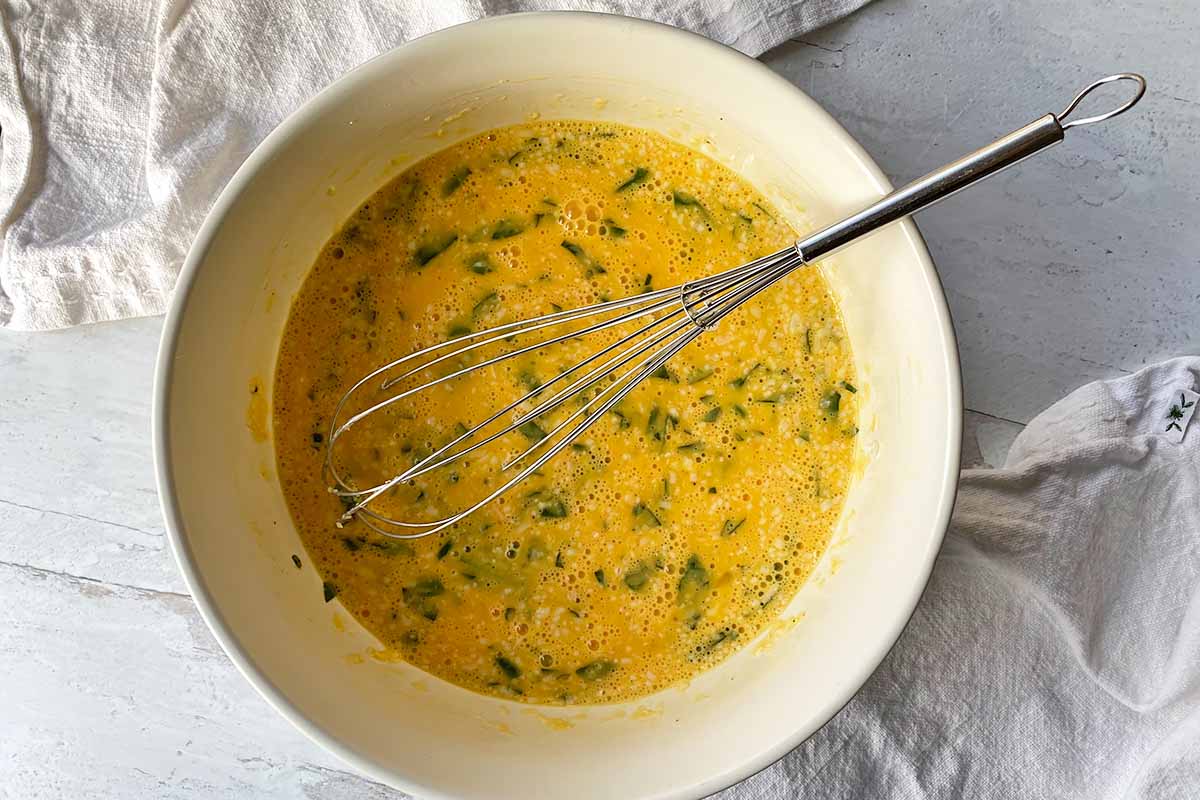
Place the heavy cream, basil, and grated Parmigiano Reggiano into the same bowl as the cracked eggs. Whisk everything together until a smooth liquid forms.
Step 6 – Pour, Assemble, and Cook
Stir in 1/2 tablespoon olive oil into the skillet and evenly disperse the garlic, scallions, and oil to thinly cover and coat the bottom of the skillet.
This extra coating of fat will prevent the frittata from sticking.
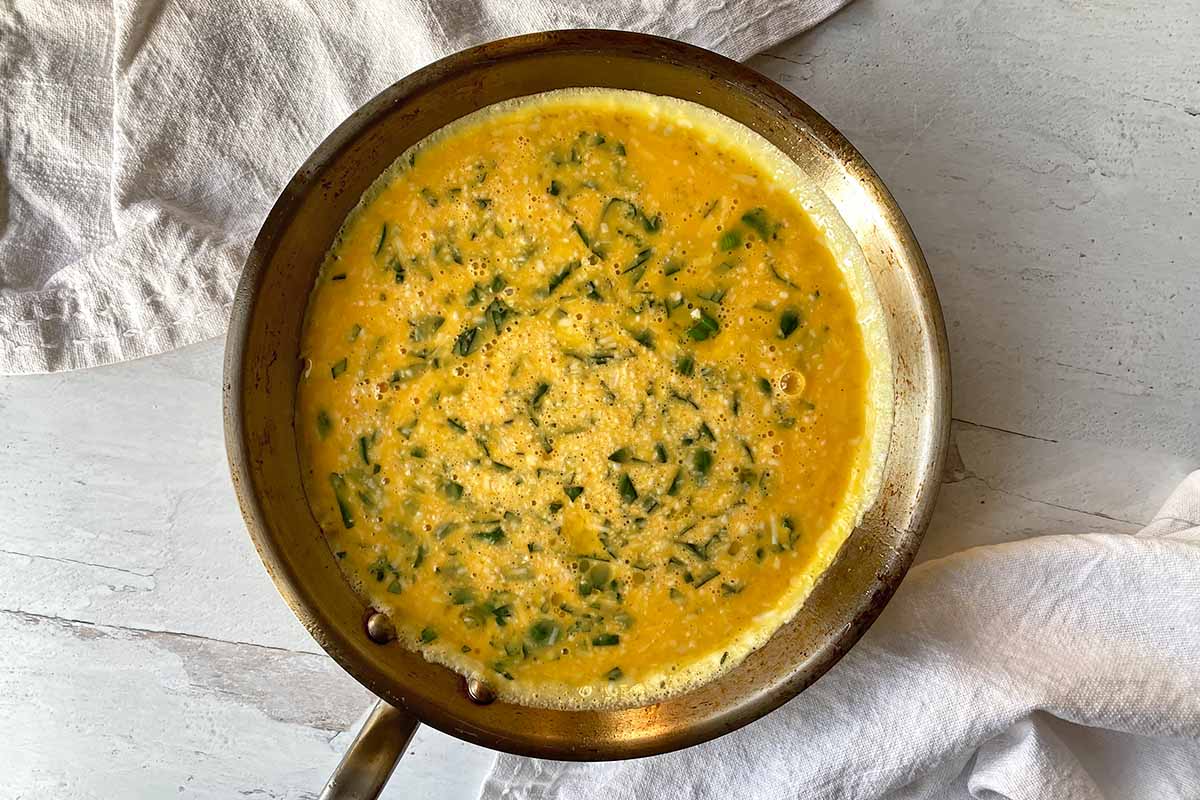
Pour the egg base over the garlic and scallions in the skillet. Evenly arrange and disperse the sausage crumbles, cubed Fontina, and roasted asparagus on the top of the frittata.
One of my biggest secrets to get some crisp, caramelized cheese bits is to ensure some of the cheese cubes touch the sides of the skillet – that direct contact with the hot metal will create an addictively caramelized, crisp exterior!
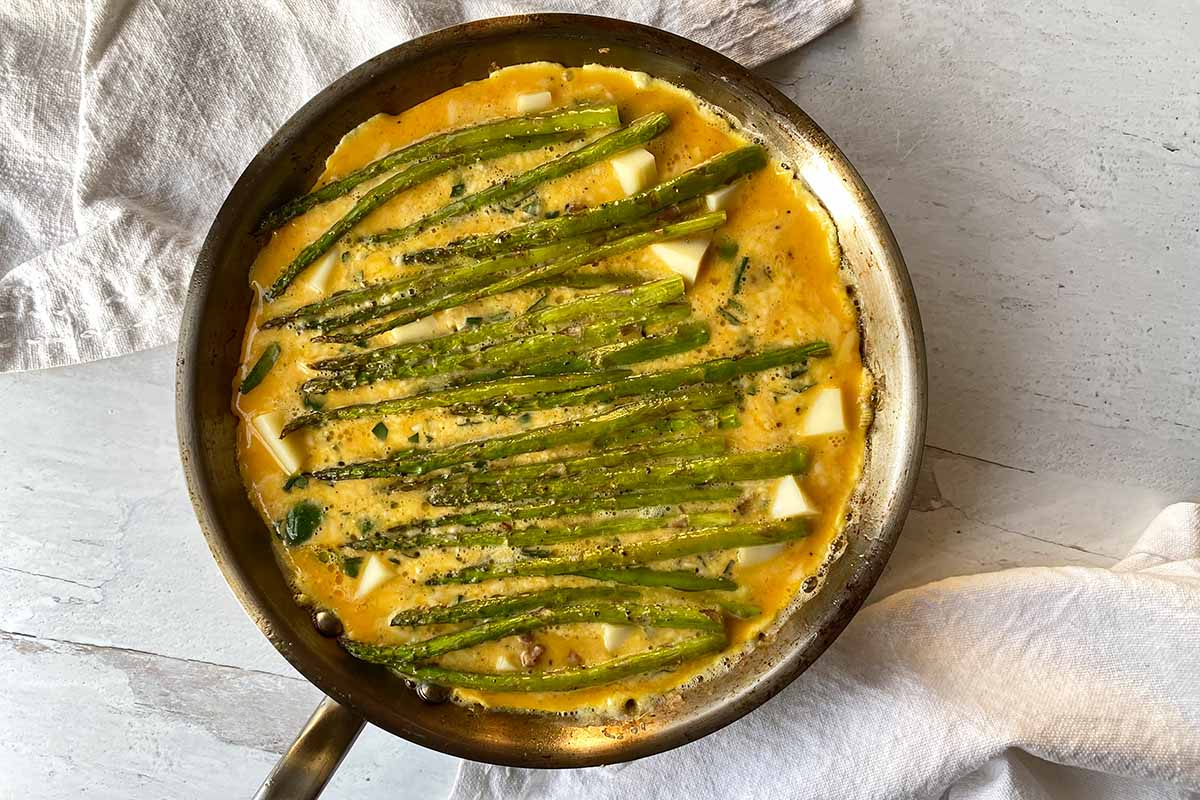
Allow the egg base to cook on the stovetop for 3 to 5 minutes on a medium-high heat setting, which develops the frittata’s beautifully browned bottom and helps it release more easily upon cutting and serving.
Don’t cook it on the stovetop for any longer than 5 minutes – you don’t want to burn it.
Step 7 – Bake in Oven
Transfer the skillet to the hot oven, and cook for 12-15 minutes.
It’s easy to overcook a frittata, which will yield dry and excessively spongy end results – not what you want!
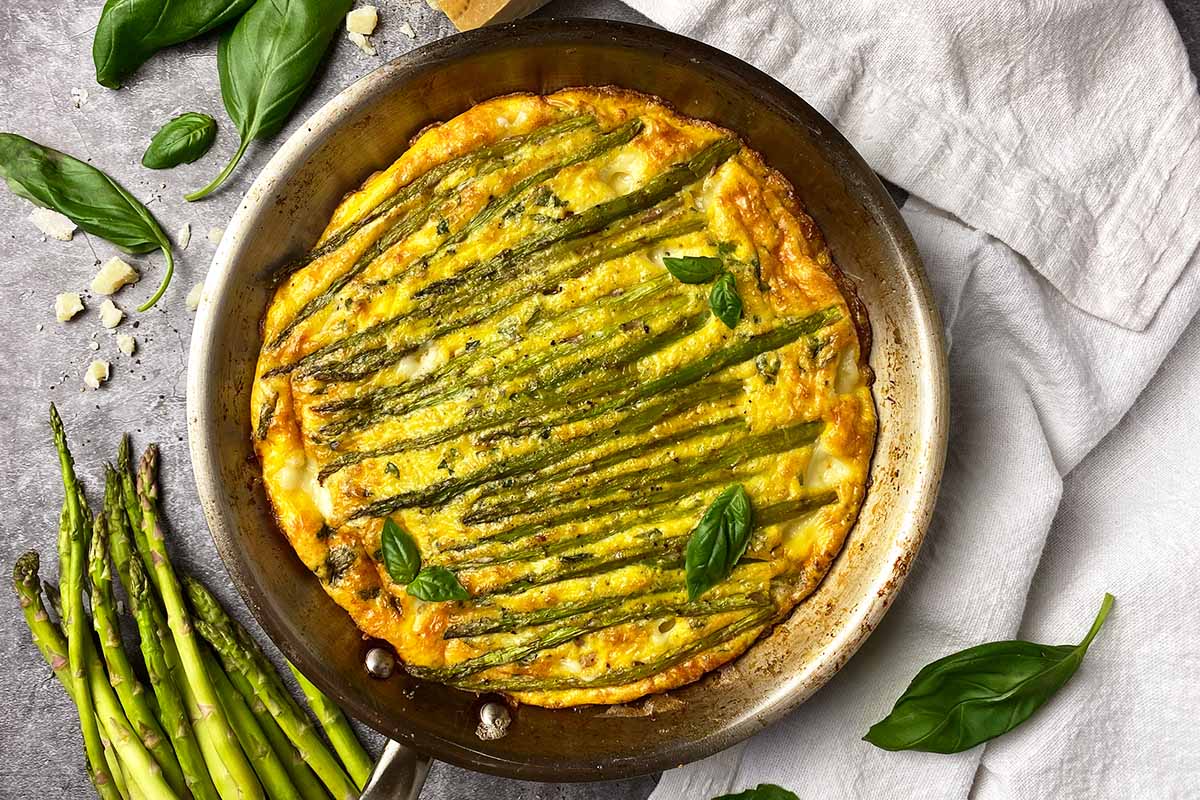
Check for its doneness at the 12-minute mark. The frittata should be puffy, and the surface should look fairly dry. The very center of it should have a slight jiggle when you gently shake the pan – this ensures the frittata will still be tender and moist once it finishes setting outside of the oven.
If it still appears too liquidy, continue baking for a few more minutes and check again.
Step 8 – Serve
Once baked, remove the skillet from the oven and allow the frittata to cool slightly to finish setting, only for 1 to 2 minutes.
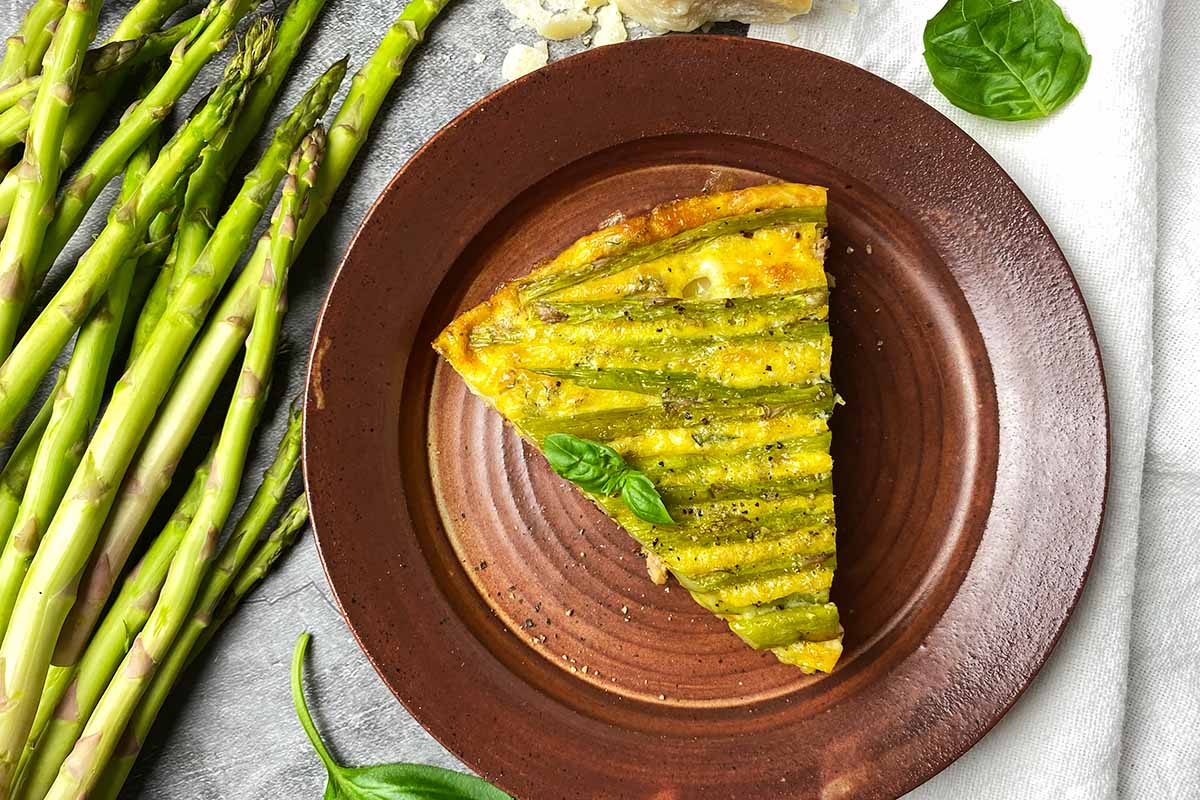
Check for seasoning. You may need to sprinkle a little salt and pepper on top for any final adjustments.
You can serve it directly in the skillet, or carefully remove it from the skillet by gently moving a pliable spatula in between the crust of the frittata and the skillet to release it. Transfer it to a serving platter.
Whatever you do, be careful! The handle will still be very hot, so make sure you use a pot holder.
Cut it into wedges and serve.
Love Those Leftovers
Because of the frittata’s ease and versatility, there are infinite possibilities for you to personalize and change the fillers with your own favorite list of ingredients.
This is an ideal concept especially when you have some leftovers sitting in the fridge!
You might already have some roasted asparagus ready to go for this recipe, but that can be replaced by other cooked veggies, anything from roasted broccoli to sauteed Swiss chard.
As for the meat, use up that oven-baked bacon you made over the weekend for brunch, or throw in some leftover roasted chicken or pork tenderloin from dinner the other night.
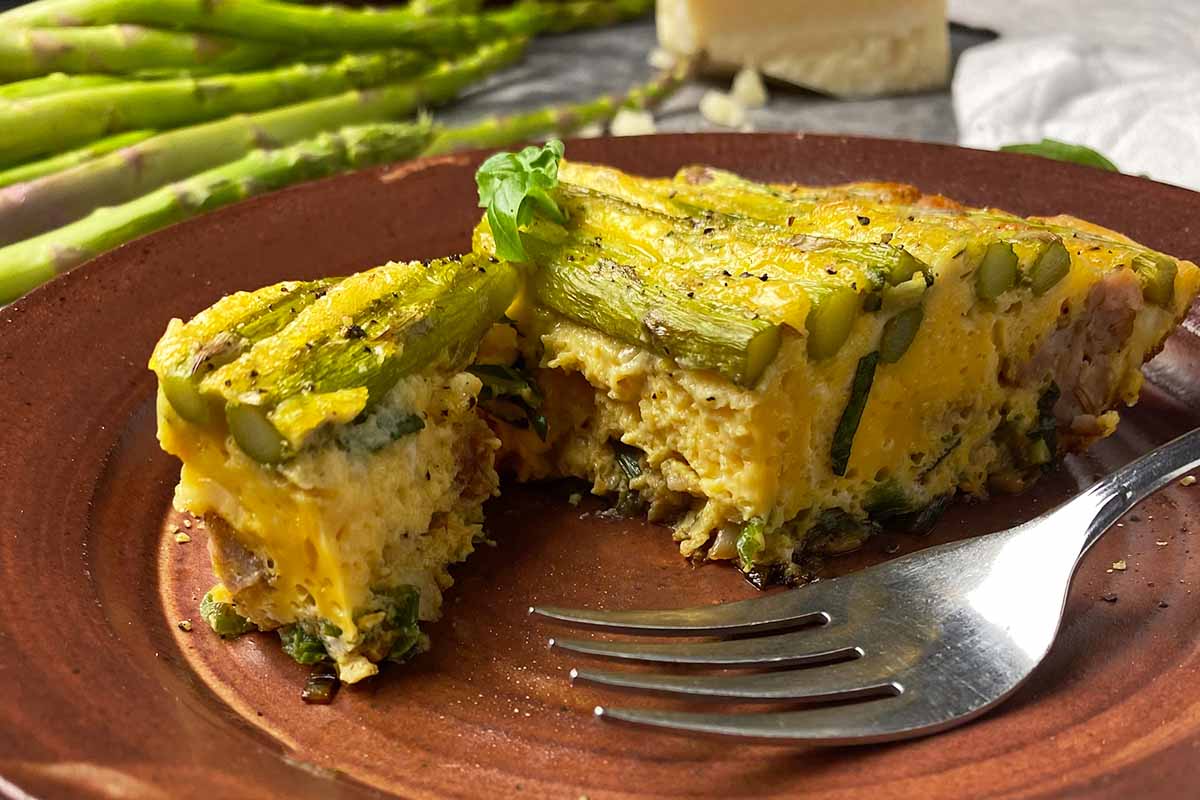
For ingredient inspiration, take a peek at our other recipes for a Spanish chorizo and potato or a vegetarian potato and zucchini frittata.
And the frittata itself also is great to enjoy as a leftover – that is, if you even have any left to store after your friends and family get their fill!
Store any remaining wedges in an airtight container in the refrigerator for up to 3 days, and reheat in the microwave or in your oven. And watch that cheese get gorgeously gooey and melty all over again!
What are your own special techniques to make the best frittatas in your house? Share a piece of advice or two in the comment section below.
Keep the asparagus recipes coming! Here’s three more fresh suggestions for you to make next:
- Fruity Asparagus Salad
- Pesto Chicken Pasta with Asparagus and Sun-Dried Tomatoes
- Lemon Asparagus Risotto
Photos by Nikki Cervone, © Ask the Experts, LLC. ALL RIGHTS RESERVED. See our TOS for more details. Originally published by Lorna Kring on March 30, 2015. Last updated on February 22, 2024.
Nutritional information derived from a database of known generic and branded foods and ingredients and was not compiled by a registered dietitian or submitted for lab testing. It should be viewed as an approximation.
About Nikki Cervone
Nikki Cervone is an ACS Certified Cheese Professional and cheesemonger living in Pittsburgh. Nikki holds an AAS in baking/pastry from Westmoreland County Community College, a BA in Communications from Duquesne University, and an MLA in Gastronomy from Boston University. When she's not nibbling on her favorite cheeses or testing a batch of cupcakes, Nikki enjoys a healthy dose of yoga, wine, hiking, singing in the shower, and chocolate. Lots of chocolate.

